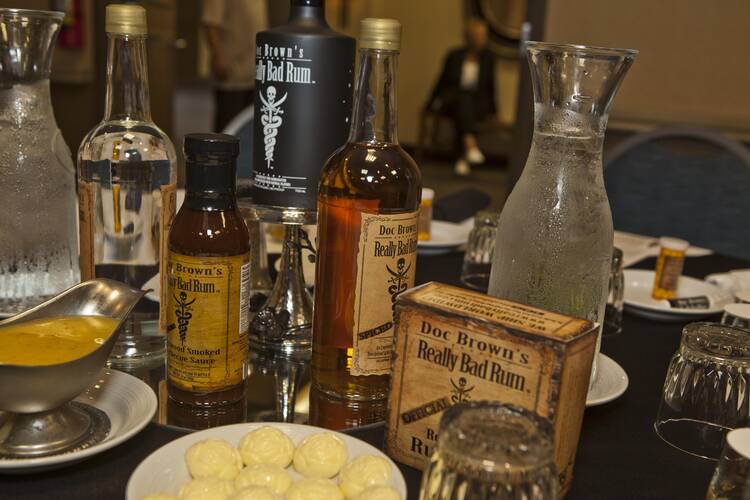For centuries, rum has had a bad rep. It has long been branded the juvenile delinquent of spirits—fuel for marauding pirates and vomiting spring breakers. Legend has it that 18th-century buccaneer Blackbeard lit gunpowder in his rum before quaffing it.
But in the 21st century we are seeing rum rehabilitated. Rum respected. A rum revolution. Or as connoisseurs like to call it, a rum renaissance. They are not talking about rum you drink with Coke or a tacky cocktail umbrella; they are proclaiming rum you drink after dinner. Captain Morgan has morphed into Courvoisier and the Caribbean is becoming the new Cognac.
“Rum makers keep raising the bar these days,” says rum expert extraordinaire Rob Burr, who publishes the blog “Rob’s Rum Guide” from his Tiki-inspired home south of Miami. He stores some 2,000 bottles of fine rum from all over the world, their prices ranging from $25 to $250.
“Each year the creativity and sophistication is more on par with Cognacs or fine Scotches. Everybody’s putting out more reserves and limited editions.”
We are seeing rum rehabilitated. Rum respected. A rum revolution. Or as connoisseurs like to call it, a rum renaissance.
A look at Mr. Burr’s most recent list of rum picks leaves little doubt this is premium stuff best sipped from tumblers and snifters. Like the just released Diplomático Mantuano from Venezuela, aged eight years, whose tasting notes—yes, rum tasting notes—include cinnamon, black treacle and polished oak. Or Mount Gay 1703 Master Select from Barbados, aged 10 years. Or Abuelo Oloroso XV from Panama, 15 years.
Rums like these will be the stars of the annual Rum Fest that Mr. Burr will host in Miami from April 22 through 23. It draws about 12,000 visitors each year.
Rum’s renaissance is not just about the perceived qualities of the cane alcohol; it reflects the elevation of Caribbean character. Or more specifically, its terroir—a term usually reserved for winemaking, speaking to the climate, soil, topography and general aura of the place where a drink is created.
Like wine grapes, sugar cane has its own knack for coaxing out the rich flavors and fragrances of the Caribbean: pineapple and banana, cocoa bean and cola nut, vanilla and guava. Like wine, Cognac and Scotch, fine rum is aged in barrels. But since it does so in tropical heat, the process is faster and employs a method called “solera,” which blends rums of different ages.
Distilling fine rum, as a result, is now a celebrated art, and master blenders like Lorena Vásquez of the Zacapa distillery in Guatemala have achieved celebrity status.
“These rums,” Ms. Vásquez told me a few years ago, “have become some of the Caribbean’s most prized ambassadors. They’re a marvelous reflection of our culture.”
And one with a more profound story than Blackbeard lore.
Before the mid-19th century, most rum was indeed rotgut. That changed thanks to the broken heart of one Dupré Barbancourt.
Mr. Barbancourt was a French Cognac maker. When his wife died, sadness drove him across the Atlantic to Haiti. There he became captivated by rum distilling and, in 1862, he started the company that still bears his name. More important, he introduced many Cognac distilling secrets to rum making. (Other rum producers like the Barcardí family in Cuba followed suit.) They would be refined and become the basis of the process masters like Ms. Vásquez use today.
But if the Caribbean is fine rum’s source, Miami is its stage—Mr. Burr’s Rum Fest being a prime example, but hardly the only one. From South Beach bistros to Brickell cigar bars, aged rums are poured there the way Glen-this and Glen-that Scotches are scrutinized in Edinburgh. The Coral Gables restaurant Ortanique offers more than 80 aged rums.
Which is fitting. For all its new respectability, rum still possesses a more hip cachet than Cognac or Scotch, and like Miami itself, it appeals to millennials as well as retirees.
In the broader picture, the rum renaissance is the latest chapter in a spirits saga with deep Roman Catholic roots. Medieval monks, after all, invented distilling. They believed it produced liqueurs with medicinal benefits—aquae vitae.
A good sipping rum may not be the water of life. But the Old World brothers were on to something, and, delightfully, their revolution flows on in the New World.










